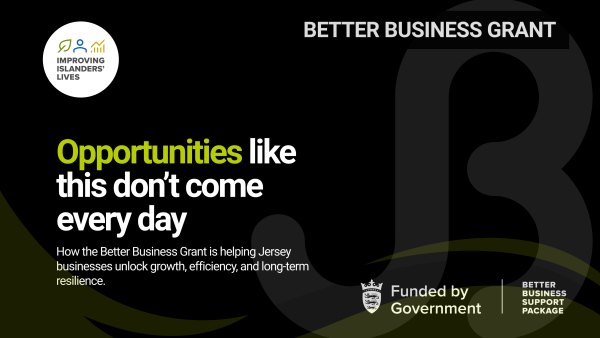Government is supporting businesses with a £20 million package of measures designed to improve skills, promote productivity and protect competitiveness as part of its priority to implement the living wage. Many of these will be delivered through the Better Business Support Package which will enable businesses to access productivity and skills training grants via Jersey Business.
Jennie Smith, Head of Business Support at Jersey Business, offers an update on the Better Business Support Package scheme

It’s four months since the Better Business Grants were launched and, during that time, our team at Jersey Business has been busy reviewing applications and supporting businesses with their plans on how to operate more efficiently. It’s been an extremely rewarding experience, mainly because of the number of businesses that have demonstrated that investing can save them money and help them grow.
The cost of us not doing it
It’s very easy to sit down and analyse the statistics, the number of applications, what sectors they represent and how many were for major and minor grant applications, and we can look at that later. But I think it would be more useful to start by looking at the behavioural challenge around making investments. This grant process is helping businesses change how they look at investment because it encourages them to break down their project into cost savings, revenue uplift and streamlined processes.
Take a tech project, for example. If automation removes three hours a week from employee A, ten hours a week from employee B and removes human error that leads to customer frustration and reworking, you are saving 13 hours a week. Multiply that by 52, and the case for investment becomes crystal clear. It’s game changing. What could your business achieve if you freed up 13 hours a week?
Some of the projects we’ve seen have articulated this brilliantly. When you map it out like that, you’re suddenly faced with the cost of not doing it. Those people could be freed up to do more value-add work, such as improving customer service or increasing revenue. These are some of the positive unintended consequences that businesses are seeing.
The 2024 Productivity Survey that we undertook backs this up: respondents reported that, on average, 25% of their working day is unproductive, a reminder of the cost of inefficient processes. The grant has helped many businesses identify and act on these inefficiencies.
Changing Perspectives
Even seasoned professionals who have been through similar grant application processes before are changing the way they look at investment projects after working with us. Unlike applying for funding from a financial institution, our focus is about the benefit and outcomes to the business. It encourages them to consider the benefits and the return on investment.

Of course, we look at and manage risk. For a major grant, the applicant needs to submit their accounts, but the real focus is around what the project is going to do for the business. These grants are here to help manage the transition to the higher minimum wage, which is a real challenge for some. So, it’s great when business owners take a step back and look at how they allocate their people resources across their business. It’s not about losing people; it’s about alleviating some of that pressure from the wage bill by freeing up existing resources.
On-Island spend
Since we started the process, we are engaging with a lot more businesses than we would normally see, and that’s across all sectors. Many of those investing in larger projects are putting up more of their own money than the 50% minimum required, using the grant to boost their investment further. For every £100 of productivity grant, the businesses are investing an average of £130, and it is even higher for the Visitor Economy grants. The on-Island impact is not only to the applicant business as the data currently shows us that 62% of grant projects having significant on-Island spend – further benefiting the wider economy.
Investing in skills
Although the Productivity element of the Better Business Grant is now complete for 2025, there is still funding available for Skills, Visitor Economy, and Apprenticeship grants – and we’re seeing some extremely thoughtful applications in these areas.
Skills applications are aligning with broader business needs and supporting future proofing their operations. That includes bringing skills in-house rather than outsourcing, and for developing leadership skills. The amounts being applied for are generally lower than for productivity projects which is understandable because you are more likely to need less money to develop someone than when buying a large piece of equipment. But it would be great to see even more businesses think about investing in their people.
The 2024 productivity survey highlighted that upskilling, engagement, and wellbeing were among the key levers for improving productivity. Businesses that invest in their people are more likely to see sustained performance improvements.
Every business that is considering how the Better Business Grant will help them will be weighing up what level of investment is right for them. 86% of the applications for a Productivity Grant are for a major grant, while 70% of Skills Grant applications are for minor grants. What’s interesting is that smaller businesses, even if eligible for the larger grant, just want to make the most suitable investment decision and are not necessarily going straight for the major grant, and that’s really encouraging.
A process that works
You can understand why this is such a rewarding process for all of us at Jersey Business involved in advising and helping businesses. We really want to help, and we are truly driven by being a valuable resource for businesses to become more resilient and to thrive.
Inevitably, some of the projects do not adequately articulate the benefits of their projects, so we work very closely with those where we can see that the project has a lot of value but lacks the narrative and data to get them over the line. Often, it’s about understanding how much time is spent on a task, what the benefits will be, and what the cost savings look like.
We’ve built the application portal to help businesses extract the right information to support their bid and it’s created investment opportunities that we might not otherwise have seen, stimulating growth within existing resources.
The goal is that once the grant scheme has ended, they will continue to make investments to improve and grow their businesses without the stimulus because they’ve seen the benefit of this process. My immediate hope is that businesses will re-apply in January next year, when the Better Business Grant becomes available again, having seen the benefits of looking at their processes through this lens.
All of the grants will be available again in 2026 – so I encourage businesses to think about what those projects might look like.
 blog.gov.je
blog.gov.je